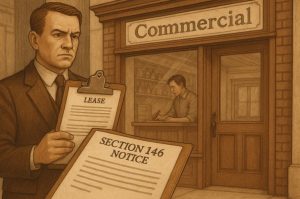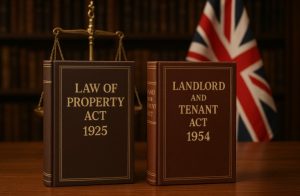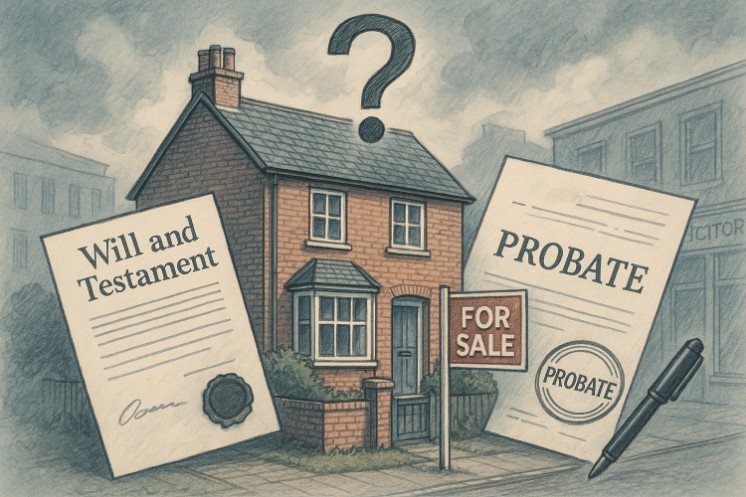Section 146 of the Law of Property Act 1925 is a statutory provision that regulates the procedure landlords must follow before taking steps to forfeit a lease due to breaches of covenant by the tenant. Forfeiture means the termination of the lease and the landlord regaining possession of the property.
This law ensures fairness by giving tenants an opportunity to address any issues before the landlord can take possession. It also outlines the formal requirements for a valid notice, ensuring landlords adhere to due process when enforcing lease terms.
Section 146 is most commonly associated with commercial leases, but it can also be applied in long residential leases where a breach has occurred. The law excludes rent arrears from its scope, which are governed by separate recovery and eviction procedures.
When Can a Landlord Serve a Section 146 Notice?

A Section 146 notice can only be served when the tenant is in breach of a covenant under the lease. This breach must not involve the non-payment of rent. Before issuing the notice, the landlord must ensure the lease grants them the right to forfeit under certain circumstances.
Typical breaches that could trigger a Section 146 notice include:
- Carrying out unauthorised alterations or structural works
- Using the property for unauthorised purposes
- Assigning or sub-letting the lease without consent
- Causing nuisance or damage to neighbouring properties
- Failing to maintain or repair the premises as required under the lease
If the lease contains a condition precedent that requires the landlord to provide notice or a chance to remedy a breach before forfeiture, that must also be satisfied.
How Should a Section 146 Notice Be Served?
Serving a Section 146 notice is a critical legal step in the forfeiture process and must be carried out with precision. If the notice is not properly served or lacks the required content, any subsequent action to forfeit the lease may be rendered invalid. This can lead to delays, additional costs, or even legal action against the landlord.
Key Components of a Valid Section 146 Notice
A Section 146 notice must meet several legal and procedural requirements to be valid. It should be drafted carefully, ideally by a solicitor or legal professional experienced in landlord-tenant law. The notice must contain the following elements:
- Specification of the Breach:
- The notice must clearly and specifically identify the clause(s) in the lease that have allegedly been breached.
- Vague or generic accusations are insufficient; the landlord must detail exactly what the tenant did (or failed to do) that constituted a breach.
- Requirement to Remedy the Breach:
- If the breach is capable of being remedied (for example, unauthorised alterations or failure to maintain the property), the notice must instruct the tenant to correct it.
- The notice should also outline how the tenant is expected to carry out the remedy and any standards that should be met.
- Demand for Compensation:
- The landlord must include a demand for compensation for any loss resulting from the breach.
- This could be in the form of financial damage, legal fees, or losses caused by the tenant’s actions.
- Reasonable Time to Comply:
- The tenant must be given a “reasonable time” to respond, remedy the breach, and pay the compensation.
- What constitutes reasonable time varies depending on the nature and seriousness of the breach. For example:
- A minor repair might require just a few days or weeks
- More complex breaches, such as structural alterations, may require several weeks or months
Methods of Service
The method used to serve the notice is also vital. The notice must be delivered in accordance with any terms specified in the lease. Where the lease is silent on this matter, the following methods are typically accepted:
- Personal delivery: Handing the notice directly to the tenant or an authorised agent.
- Recorded delivery or first-class post: Posting the notice to the tenant’s last known address or the leased premises. A certificate of posting is usually required as evidence.
- Service via solicitor: In cases where the tenant is known to have legal representation, the notice may be served to their solicitor, provided prior arrangements or consent exists.
- Email or electronic service: Only valid if the lease specifically allows for notices to be served by electronic means.
Serving the notice improperly can result in the notice being challenged or deemed invalid, which may delay or nullify any attempt to recover possession of the property.
Timing of Service
The notice must be served before any forfeiture proceedings can begin. In fact, landlords cannot issue possession claims in court without evidence that the Section 146 notice was:
- Properly served
- Contained the required information
- Allowed the tenant a fair opportunity to respond
If the landlord proceeds with forfeiture before the expiry of the reasonable time given in the notice, the tenant can apply for relief or claim the forfeiture was unlawful.
Landlord Considerations Before Serving Notice
Before serving a Section 146 notice, landlords should ensure the following:
- The lease contains a valid forfeiture clause allowing termination for breaches of covenant
- There is clear evidence of the breach (photos, reports, written complaints, etc.)
- The breach is not related to non-payment of rent, which is dealt with under different legal procedures
- No prior waiver of the right to forfeit has occurred (for example, by accepting rent after learning about the breach)
It’s also good practice for landlords to attempt informal resolution first, unless the breach is severe. Courts may look favourably on landlords who have attempted dialogue or offered a chance to comply before resorting to legal action.
Practical Tips for Ensuring Proper Service
- Always document the service method used and retain proof (e.g., delivery receipts, emails, witness statements)
- Consider using a process server for personal delivery to ensure legality
- If serving by post, use Royal Mail Recorded Delivery and keep a copy of the tracking number
- Check whether the lease includes a “notice clause”, which may impose special rules or addresses for service
Potential Consequences of Improper Service
If a landlord fails to comply with the procedural requirements, the repercussions may include:
- Delay in regaining possession
- Dismissal of forfeiture proceedings by the court
- Court orders for costs in favour of the tenant
- Potential counterclaims by the tenant for harassment or unlawful eviction
Given these risks, most legal professionals recommend that landlords instruct a solicitor to draft and serve the notice.
Key Requirements for Serving a Section 146 Notice
| Requirement | Details |
| Identify breach of covenant | Must be clearly stated and tied to specific lease terms |
| State remedy (if applicable) | Instructions for fixing the breach, with expectations |
| Demand for compensation | Details of losses and amount claimed |
| Allow reasonable time | Dependent on the nature of the breach and practical considerations |
| Serve in accordance with lease | Use method specified in lease, or legally accepted alternatives |
| Document the service | Retain proof of delivery and content of the notice |
By ensuring the Section 146 notice is properly served, landlords not only uphold their legal obligations but also strengthen their position should the matter proceed to court.
What Rights Do Tenants Have After Receiving a Section 146 Notice?

Upon receiving a Section 146 notice, tenants are afforded several important protections before any forfeiture can proceed. The law recognises that even though a breach may occur, tenants should have a fair opportunity to correct their mistake.
The tenant may:
- Remedy the breach, such as reversing an unauthorised alteration or ceasing an unauthorised activity
- Challenge the validity of the notice if it is ambiguous or incorrectly served
- Negotiate with the landlord to resolve the issue without escalation
- Apply to the court for relief from forfeiture, which allows the lease to continue despite the breach
If the tenant complies with the requirements in the notice and provides compensation where required, the landlord cannot proceed with forfeiture. This structure protects tenants from abrupt or unfair termination of leases.
How Does the Forfeiture of Lease Process Work?
Forfeiture is the legal right of a landlord to terminate a lease and regain possession of a property when a tenant breaches a term of the lease agreement.
Under Section 146 of the Law of Property Act 1925, this process is governed by a strict set of legal requirements intended to ensure fairness, prevent abuse, and give tenants the opportunity to correct their breaches.
The process differs depending on whether the lease relates to commercial or residential property, and whether the breach is considered remediable or irremediable.
Preconditions to Forfeiture
Before beginning the forfeiture process, landlords must ensure the following:
- The lease contains an express forfeiture clause allowing the landlord to terminate the lease in the event of a breach.
- A valid Section 146 notice has been served, specifying the breach, demanding remedy and/or compensation, and providing a reasonable timeframe for compliance.
- The tenant has failed to comply with the requirements in the notice within the given timeframe.
If any of these steps are not followed correctly, the landlord risks invalidating the forfeiture and may face legal claims from the tenant.
Forfeiture in Commercial Leases
In commercial property leases, landlords have two primary methods of forfeiture: peaceable re-entry or court proceedings.
1. Peaceable Re-entry
This is where the landlord physically re-enters the property, usually by changing the locks, to take back possession without involving the court. This method is permitted under English law, but only under specific conditions:
- The lease must allow forfeiture for the specific breach
- The tenant must not be present at the premises at the time of re-entry
- The landlord must not use force or engage in threatening behaviour
While peaceable re-entry can be quicker and cheaper than court proceedings, it carries significant risks. If any aspect of the re-entry is considered unlawful—such as entering while the premises are occupied—the landlord could be liable for trespass, illegal eviction, or breach of quiet enjoyment.
Because of these risks, many landlords choose to proceed through the courts, even in commercial cases.
2. Court Proceedings for Possession
This is the more formal route and often the preferred option, especially when:
- The tenant disputes the breach or validity of the Section 146 notice
- The breach is complex or unclear
- There is a risk of confrontation during re-entry
In court, the landlord applies for a possession order, which, if granted, legally terminates the lease and entitles the landlord to reclaim the property.
The court will examine:
- Whether the breach occurred
- If the tenant had a reasonable opportunity to remedy it
- Whether granting forfeiture is proportionate and fair
The court may also consider whether relief from forfeiture should be granted to the tenant (explained further in a separate section).
Forfeiture in Residential Leases
The forfeiture process for residential properties is generally more complex and must go through the court system. Peaceable re-entry is not permitted due to statutory protections afforded to residential tenants under the Housing Act 1988 and the Protection from Eviction Act 1977.
Before initiating court proceedings, landlords must:
- Serve a valid Section 146 notice (if the breach justifies forfeiture)
- Apply to the First-tier Tribunal (Property Chamber) in certain cases (e.g., for long leases) to establish that the breach has occurred
- Proceed to the county court for a possession order once the tribunal has ruled in the landlord’s favour
This layered approach reflects the higher level of protection given to residential tenants and the seriousness of terminating someone’s home.
Types of Breaches and Their Impact on Forfeiture
Whether a lease can be forfeited often depends on the nature of the breach. Some breaches are considered remediable, meaning they can be fixed, while others are irremediable.
Table: Types of Breaches and Forfeiture Eligibility
| Breach Type | Remediable? | Forfeiture Allowed? | Typical Outcome |
| Failure to repair | Yes | Yes | Tenant given time to carry out works |
| Unauthorised alterations | Yes | Yes | May require reversal of changes |
| Sub-letting without consent | Often | Yes | Tenant may seek retrospective consent |
| Use of premises for illegal purpose | No | Yes | Court more likely to allow forfeiture |
| Nuisance to neighbours | Yes | Yes | Depends on severity and efforts to remedy |
If a breach is irremediable, the landlord is generally not required to give the tenant a chance to fix it before proceeding with forfeiture. However, courts still retain discretion and may consider whether forfeiture is proportionate.
Role of the Courts in the Forfeiture Process
The courts play a critical role in determining whether the landlord has the right to regain possession. They assess:
- The validity of the Section 146 notice
- Whether the breach occurred as stated
- If the tenant had an opportunity to remedy the issue
- Whether forfeiture is a reasonable response to the situation
Even if a landlord proves a valid breach and follows all procedures correctly, the court may refuse forfeiture if it considers the action too harsh or if the tenant applies for relief.
Delays and Defences in Court Proceedings
Tenants can often delay or resist forfeiture proceedings by:
- Challenging the service or content of the Section 146 notice
- Arguing that the breach did not occur or has been remedied
- Applying for relief from forfeiture
- Citing unlawful behaviour by the landlord (e.g., accepting rent after breach)
These defences often result in the case being adjourned, or the court denying the possession order altogether.
Post-Forfeiture Considerations
Once a lease is forfeited and the landlord regains possession, several post-forfeiture issues may arise:
- The landlord must secure the property to prevent trespass or damage
- Any remaining tenant belongings must be handled lawfully (e.g., offering collection or storage)
- If the lease was a registered title, the landlord should update records with the Land Registry
- The landlord must refrain from re-letting or redeveloping the premises if relief from forfeiture is still pending
Tenants may still have a limited time to apply for relief after forfeiture has occurred, particularly in long leases and commercial tenancies.
Can a Landlord Evict Without Going to Court?

For residential tenancies, eviction must always go through the court process. Any attempt to evict a tenant without a court order is likely to be unlawful and could lead to legal consequences, including claims for unlawful eviction or harassment.
In commercial lease scenarios, peaceable re-entry may be allowed but is often discouraged due to its legal complexity. The premises must be unoccupied at the time, and any form of confrontation or force may render the forfeiture invalid.
Summary of Eviction Pathways:
| Lease Type | Can Use Peaceable Re-entry | Must Use Court Process | Risk of Illegal Eviction |
| Commercial Lease | Yes (in limited cases) | Optional | Medium |
| Residential Lease | No | Mandatory | High |
For this reason, most legal professionals advise landlords to initiate court proceedings for possession, even in commercial lease disputes, to ensure compliance with legal standards.
What Happens If the Tenant Applies for Relief from Forfeiture?
Tenants who receive a Section 146 notice and subsequently face forfeiture proceedings have the right to apply to the court for relief from forfeiture. This legal remedy allows the tenant to remain in possession of the property, provided they can demonstrate a willingness and ability to address the breach.
Relief is discretionary, meaning it is up to the court to decide whether it should be granted. Courts generally favour granting relief unless the breach is severe or repeated.
To obtain relief, the tenant usually must:
- Remedy the breach (if possible)
- Pay the landlord’s legal costs
- Pay compensation for the landlord’s losses
- Demonstrate a commitment to future compliance
Relief must typically be applied for before the possession order is executed, although the court has discretion to allow late applications in certain situations.
Conditions Often Required for Granting Relief:
| Requirement | Purpose |
| Remedy the breach | Shows responsibility and effort to comply |
| Compensate the landlord | Covers financial loss from the breach |
| Pay legal costs | Reimburses the landlord for court and solicitor fees |
| Promise future compliance | Assures the court the breach won’t recur |
This mechanism exists to prevent disproportionate punishment for relatively minor breaches and to preserve the tenant’s rights when they act in good faith.
How Does Section 146 Interact with the Landlord and Tenant Act?

The Landlord and Tenant Act 1954 governs the rights of tenants in business premises to renew their leases and protect against arbitrary eviction. Section 146 of the Law of Property Act 1925 must operate alongside the 1954 Act, particularly in commercial lease contexts.
Where the 1954 Act applies, landlords may be restricted from using forfeiture unless specific conditions are met, such as proving persistent breaches or establishing that the tenant is not entitled to lease renewal.
Key points of interaction include:
- Protection from forfeiture during lease renewal disputes
- Additional notice requirements under the 1954 Act
- Requirement for court involvement even where the lease permits peaceable re-entry
Commercial landlords must carefully assess whether the tenant has statutory protection before relying on Section 146, and tenants should be aware of their rights under both Acts.
What Should Landlords and Tenants Know to Avoid Disputes?
Avoiding disputes under Section 146 starts with clear communication and well-drafted lease agreements. Both parties benefit from knowing their obligations and rights in detail.
Best practices for landlords include:
- Carrying out regular inspections to identify issues early
- Maintaining accurate documentation of breaches and correspondence
- Including clear forfeiture clauses in the lease
Tenants can prevent escalation by:
- Promptly addressing any breach notifications
- Keeping the landlord informed of intended changes to the property
- Seeking legal advice when unsure about lease obligations
Disputes often arise from misunderstandings or poor communication. Addressing problems proactively and seeking mediation when necessary can reduce the need for legal proceedings.
Conclusion
Section 146 of the Law of Property Act 1925 is a powerful tool that enables landlords to enforce the terms of a lease. However, it also protects tenants by ensuring they receive proper notice and a reasonable opportunity to remedy any alleged breach.
Both parties, landlords and tenants should understand the requirements, risks, and protections surrounding Section 146. When used appropriately and with proper legal guidance, it can help resolve disputes while maintaining fairness and due process.
FAQs
What is the main purpose of a Section 146 notice?
A Section 146 notice formally notifies a tenant of a breach in their lease and gives them the opportunity to remedy it before forfeiture proceedings are initiated.
Can a landlord forfeit a lease immediately after a breach?
No. The landlord must first serve a Section 146 notice giving reasonable time for remedy and compensation before taking action.
Is legal advice necessary for serving or responding to a Section 146 notice?
Yes, due to the legal complexity and consequences of forfeiture, both landlords and tenants should consult legal professionals.
Does Section 146 apply to assured shorthold tenancies?
Not typically. Section 146 is more applicable to long leases or commercial leases, not short-term residential agreements governed by the Housing Act.
What qualifies as a breach of covenant under a lease?
It can include structural alterations, nuisance, illegal activity, failure to repair, or violating usage terms in the lease.
What happens if a landlord serves an invalid notice?
An invalid Section 146 notice can be challenged in court and may prevent the landlord from lawfully terminating the lease.
Is it possible to settle a dispute without going to court?
Yes. Many disputes under Section 146 are resolved through negotiation, mediation, or compliance within the timeframe provided.






